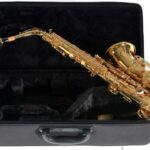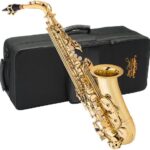The saxophone has always been a stellar instrument in jazz, military bands, and classical and solo performances. It seems like the saxophone has gained so much popularity in the last decade. As with playing any instrument, the saxophone comes with pros and cons.
What are the pros and cons of playing the saxophone?
Pros:
- It’s fairly easy to play
- It’s versatile
- Learning to play other woodwinds will be easier
- Beautiful instrument with charisma
- Can be played solo or with a band
- Improves your memory
- It’s relaxing
- It makes you smarter
- It’s a sociable instrument
- It’s a totally cool instrument
Cons:
- You might sound honky at first
- Can be difficult to transport
- Takes years to be a master
- Needs maintenance
- Few orchestra pieces for the sax
Read on to learn more about the pros and cons of sax, as well as some essential mastering tips.
Also, we hope you find the links here useful. If you purchase something through a link on this page, we may get a commission, so thank you!
Also, for an excellent saxophone, take a look at our top pick, the Eastar AS-Ⅱ Student Alto Saxophone:
Click here to see it on Amazon.
Pros and Cons of Playing Saxophone

Learning to play any musical instrument can seem daunting. There are so many instruments to choose from. Just picking from the classification of instruments – woodwind, strings, and percussion can be formidable enough. To help you decide if the sax is for you, here are the pros and cons of playing the instrument.
The Pros
1. It’s Fairly Easy to Play
The saxophone is a relatively new instrument in the wind category; thus, it has an easier finger system as compared to other wind instruments. It is also easy to produce the correct tone with the sax. Many music teachers recommend learning on the alto sax because of its medium size, making it easier to manage than the larger ones. The alto sax also has the most material to learn from.
The tenor and the baritone sax are larger than the alto sax which might make it harder to maneuver for the beginner. The baritone sax is actually 4 feet tall!
A good alto saxophone for the beginner is the Eastar AS-Ⅱ Student Alto Saxophone. It has a beautiful sound, has an easy-to-use design, and is very affordable. It comes with a one-year warranty.
Click here to see it on Amazon.
Another great entry-level saxophone is the Jean Paul USA AS-400 SP Student Alto Saxophone. It has a beautiful tone and outstanding intonation for its price point. It also comes with a reed, case, cork grease, gloves, cloth, swabs, and mouthpiece.
Click here to see it on Amazon.
Below is a great review video of the Jean Paul USA AS-400 SP Student Alto Saxophone – one of the best affordable alto saxophones around.
2. It’s Versatile
The saxophone has a distinct sound that is flexible for various genres like jazz, classical, pop, blues, rock, and marching bands. Basically, there are four types of saxophones, and each is used for certain genres:
Tenor saxophone – The tenor saxophone is relatively large in size. It is used in modern-day jazz and rock. It plays in the key of B flat. A good choice for a tenor saxophone is the Jean Paul USA Silver-Plated Intermediate Tenor Saxophone. It has great tone quality with keys that are easy to play and is at an affordable price compared to many other tenor saxophones.
Click here to see it on Amazon.
Alto saxophone – The alto saxophone is medium in size and is recommended for beginners. It is the saxophone commonly used in school bands. It plays in the key of E flat.
Soprano saxophone – The soprano saxophone is the highest-pitched in the saxophone family. The soprano sax is often used by advanced and professional saxophonists and takes some getting used to. It is often used in jazz bands.
Baritone saxophone – It is the largest in the saxophone family, and you actually need a harness for support as it is quite heavy. It plays in the key of E flat and has a very deep sound. It is often used for jazz solos. It is used in military bands, chamber music, and jazz.
If you’re looking for a great baritone sax, check out this Estella BS200 Lacquer E Flat Baritone Saxophone. It comes with a mouthpiece, neck strap, carrying case, and polishing cloth.
Click here to see it on Amazon.
3. Learning Other Woodwinds Will Be Easier
When you’ve mastered playing the saxophone, it will be easy to transition to other woodwind instruments. The clarinet and flute specifically have almost the same finger system as the saxophone. The flute has almost the same exact register as the soprano and alto saxophone.
4. Beautiful Instrument with Charisma
The saxophone is a beautiful instrument. Look at it, just look at it! The shape, the shiny finishing of the saxophone are just timelessly beautiful. The instrument has charisma because the wide dynamic range and tonal colors it offers make it possible to convey emotions musically.
5. It Can Be Played Solo or with a Band
The saxophone can easily be a superstar when it is played solo. And because it is a harmonious instrument, fitting in compositions, it can easily be a team player when played in a band.
6. It Improves Your Memory
A great deal of brainpower is required for playing the sax. It is like a total workout for your brain to keep it “fit”. When playing the sax, your brain becomes more active, sort of like multi-tasking. It requires reading and hearing notes, and at the same time, motor and cognitive skills for finger movement.
7. It is Relaxing
The saxophone has that very distinct sound that is soothing, almost sensual, and smooth. Wouldn’t you want to play an instrument that has a relaxing sound? That’s exactly what saxophone music is. It is never uproarious or disorderly.
8. It Makes You Smarter
There has been a study that says that people who play musical instruments are better at abstract reasoning, math skills, and coordination in general. Playing the sax teaches you patience, perseverance and improves leadership skills. [1]
9. It’s a Sociable Instrument
Because the saxophone can very well fit in a band, it makes you able to get involved in a huge variety of musical groups and events. Playing in a band shows you the value of teamwork and leadership skills as well.
10. It is a Cool Instrument, Overall
The saxophone is a cool instrument known for jazz, classical, and rock music and is known for having an abundance of solos for these music genres. And, let’s face it, playing the sax can make it easier to impress the opposite sex. There’s just something mystically hot about the saxophone!
The Cons
As with all instruments, there will be a downside to learning how to play. The saxophone is no exception. Here are some cons of playing the saxophone:
1. Your First Few Lessons Will Sound Honky
While the finger movement can be relatively easy to learn, the blowing part can be tricky. The first time you play saxophone, you will have no idea how to put the mouthpiece in your mouth properly. When you first blow into it, you’ll get squeaky and honky sounds. This off-sound is quite normal at first, and you will get better at it with practice.
2. They Can Be Cumbersome to Carry
The saxophone is definitely not a small instrument, and neither is it light. The baritone saxophone, which is the largest in the sax family, can weigh anywhere from 15 to 35 pounds!
The medium-sized alto sax can weigh anywhere from 4 to 6 pounds. The saxophone may look like a sturdy instrument but really, it is a fragile one. Accidentally dropping it might damage the pieces, and it can be expensive to replace. It is always advised to carry your saxophone in a case.
3. It Is Easy to Learn but Takes a Long Time to Master
To be really good at the sax, you will need years of constant practice. Yes, you may say it is the same for any other instrument. However, with playing the saxophone, you will need your fingers, hands, lips, mouth, throat, larynx, and lungs! That’s a lot of body parts that need to work together! Coordination will take some time, and numerous hours of practice are needed.
4. Needs Maintenance
The sax will need regular maintenance like re-corking and re-padding. The mouthpiece especially will need special care as it is the part that comes in contact with your saliva. If you drink or smoke or eat spicy food, then your saliva can, in the long run, damage the mouthpiece. As you continue your saxophone lessons, you will need to buy different types of reeds, mouthpieces, and even ligatures.
5. Rarely Does the Saxophone Play in an Orchestra
For the very reason that the saxophone is relatively a new instrument, there aren’t many orchestra pieces that include the saxophone. So, if you’re a saxophonist, expect to be excluded from joining the orchestra unless you double as a clarinet or other woodwind player.
Some Tips for Playing the Saxophone

We now know that the pros outweigh the cons in saxophone playing. If you’ve decided to play the sax and start playing soon, here are a few tips on playing.
Practice, practice, and then practice some more. Regular practice will develop and maintain your embouchure. Embouchure is the way a player applies his/her mouth to the mouthpiece of a brass or woodwind instrument. Daily practice is encouraged, and to help you do this, music teachers often ask you to place your saxophone outside its case, somewhere where you can see it every day. This will be your daily reminder to pick it up and play it every day.
Purchase a music stand like the KM Orchestra Music Stand and place your music there, at eye level. If you place your music flat on a table, your posture will be affected.
Click here to see it on Amazon.
Practice your breathing. A big part of being a successful saxophonist will rely on your flow of breath while playing. The saxophone demands more breath than any other instrument. Your flow of breath should be constant. Your throat should be open while playing, and make sure that you draw breaths from your diaphragm.
Choose a position when you play and stick to it. There are commonly 2 positions for playing – with the instrument between your legs or towards your right side. Stick with whatever you choose and practice the same way always. If you switch back and forth between the two positions, it could affect how you play.
Choose your reeds wisely. If you’re truly, wholeheartedly committed to playing the saxophone, invest in a good one even though it may be more expensive. Higher quality reeds will have less tendency to splinter in your mouth. Be sure to choose saxophone reeds with a mouthpiece that is of the right hardness for you.
Take note of your dynamics. Music is a form of expression, and the saxophone is an instrument that can very well convey emotions through music. It’s an opportunity to make your listeners feel what you’re feeling. Create the dynamics to enhance the mood of your listeners. You may switch from playing at a high volume to a softer, more mellow volume. Be creative, and don’t be afraid to experiment.
Take care of your saxophone. Saxophones may look heavy-duty, but if you drop or bang it against something the wrong way, then you might end up needing to have it repaired, or worse, replaced. Treat your saxophone as you would treat a pet – with utmost loving care.
Take your saxophone for regular maintenance and clean it regularly. Wipe it clean after every time you play with a lint-free cloth to ensure that it is free of moisture that can damage it. You will encounter stuck or loose keys as you practice with your saxophone. Find a good, reliable, qualified repair technician.
Conclusion – Pros and Cons of Playing Saxophone
What are the pros and cons of playing the saxophone?
Pros:
- It’s fairly easy to play
- It’s versatile
- Learning to play other woodwinds will be easier
- Beautiful instrument with charisma
- Can be played solo or with a band
- Improves your memory
- It’s relaxing
- It makes you smarter
- It’s a sociable instrument
- It’s a totally cool instrument
Cons:
- You might sound honky at first
- Can be difficult to lug around
- Takes years to be a master
- Needs Maintenance
- Few orchestra pieces for the sax
With these 10 pros and 5 cons, you can see the saxophone has a lot going for it. If you decide between which instrument to play, the sax is an excellent choice. As long as you don’t have a dream of playing in an orchestra, the saxophone is great for any aspiring musician wanting to play solo or in a band.
Related reading:
How to Play Saxophone [Learn by Yourself]
Best Saxophones – [Alto, Tenor, Soprano, and Bari]
What Instrument Does Kenny G Play? [Kenny G Instrument]
Different Types of Saxophones [4 Most Common and 6 Less Common]










